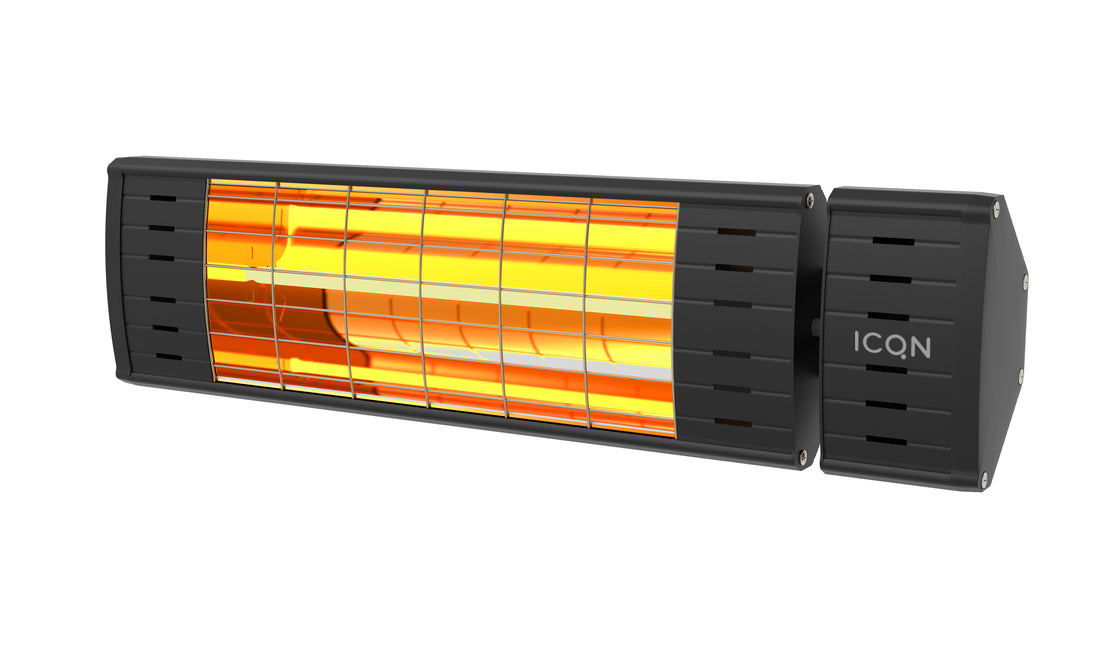
Electric Infrared Space Heating
Share

Heat is transferred in three ways: convection, conduction, and radiation. In most space heating systems, convection and conduction are the principle heat transfer mechanisms. Infrared (IR) space heating is accomplished through electromagnetic radiation. Natural gas, propane, and electricity are the fuels commonly used by IR heaters. Although these heaters are commonly referred to as "space heaters," they do not directly heat the space: they heat the objects in the space, which, in turn, eventually heat the space. The term "infrared space heating" is used to distinguish comfort heating from IR process heating.
Electric IR heaters have two basic components: an IR heating element and a reflector. The IR heating element is composed of a resistor material (or radiator) that gives off electromagnetic energy in the IR portion of the spectrum when excited by an electric current. The resistor material is partially enclosed in the reflector, a fixture that reflects the radiation toward the people to be heated. Resistor materials include tungsten wire in a quartz tube, nickel chromium alloy in a quartz tube, tungsten wire in a reflector lamp, and nickel chromium alloy in a metal rod. In space heating applications, the IR radiation is normally directed toward the people in the area. However, the radiation also strikes objects, such as the floors, walls, equipment, and furnishings. These objects then retransmit the heat they receive, Through secondary, conduction, convection, and radiation. In this way, IR heaters can be used to warm the air in a room to a set temperature, much like a conventional heating system.
Tungsten wires in quartz lamps and reflector lamps operate at filament temperatures of about 4050°F and radiate energy in the "near-infrared " portion of the spectrum. These lamps have the added advantage of providing visible light of approximately 8 lumens per watt. This can help illuminate work areas. The potential downside is that when heating is not needed, the extra light is not provided. Other lamp elements, such as metal sheath, open wire, and ribbon elements, operate between 1200 and 1800°F and emit in the "far-infrared" portion of the spectrum.
Advantages
- Relatively inexpensive and easy to install compared to conventional HVAC systems
- Keeps people comfortable in relatively areas such as bus stops, covered breezeways, loading docks, outdoor restaurants, and garages.
- Reduces the overall energy required to heat an area by allowing a background temperature of 50-60°F.
- Simple to lay out, control, and maintain.
- Can be used to heat "trouble spots" such as lobby areas, hallways, and entrances.
- Less complicated than gas heating because neither gas piping nor ventilation of combustion by-products is necessary.
Disadvantages
- If systems are used to maintain space temperatures of 68-70°F, the overall efficiency is no better than conventional resistance heating.
- Mounted at ceiling heights of over 30 feet, IR lamps do not keep people warm.
- People need to be radiated from both sides to feel comfortable. That is, enough lamps must be installed to produce a criss-cross pattern.
Best Applications
- Areas exposed to the outdoors and/or areas that require high ventilation rates.
- The ideal application is an area maintained at 50°F in which IR heaters are used only to warm people. An example is a large warehouse watched over by a stock person near the main door. IR heaters could be installed where the stock person spends the most time, providing the stock person hearing comfort irrespective of the overall warehouse temperature.
- Storage rooms, garages, loading docks, covered walkways, warehouses, gymnasiums, commercial/industrial plants and shops, outdoor restaurants, and store entrances.
Applications to Avoid
- Applications requiring narrow range of heating and cooling temperature control throughout the space under consideration. Examples: Offices, classrooms, patient rooms, theaters, etc.
- Applications requiring number of air changes per hour irrespective of temperature control.
Technology Types (Resource)
IR lamps and fixtures are available in a variety of shapes and sizes. They are normally hung from or attached directly to the ceiling, in a manner similar to a lighting system, with careful attention to the maximum height of forklifts, trucks, cranes, etc., that operate in the area. The IR -system designer determines the desired energy levels for the different parts of the facility and then estimates the equipment wattage required to produce the desired energy levels. The fixtures are typically available in 120-, 240-, and 480-volt systems.
Efficiency
The lamp efficiency depends on the material of the resistor the radiator. Clear quartz lamps have an efficiency of about 96%. Tungsten wire and quartz tubes have efficiencies of 60-80%. Metal rods have lamp efficiencies as low as 50%. The overall efficiency of the IR system depends on the type of IR element in the lamp, the absorptivity of the people, and the objects near the lamp, and the efficiency of the fixture (including the reflectivity of the reflector and the directional efficiency of the fixture). Other factors to consider in selecting an IR element include amount of visible light output, time required to develop full output, vibration resistance, and color of light. The life expectancy of any IR lamp is about 5000 or more hours.
